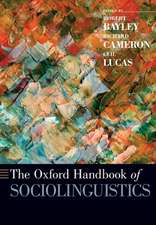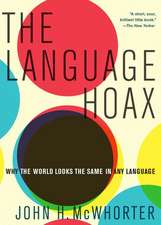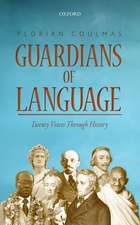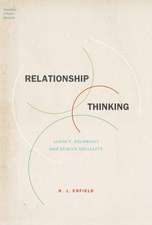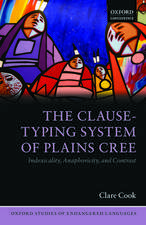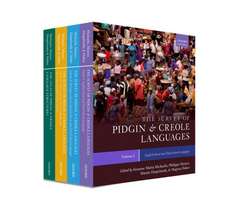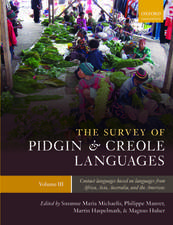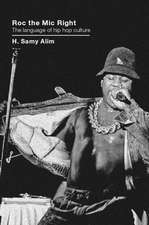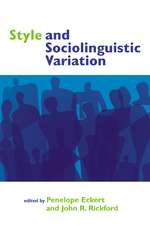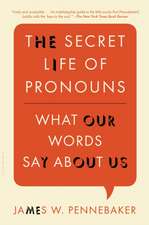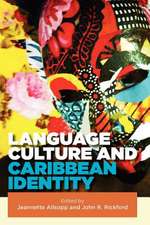Raciolinguistics: How Language Shapes Our Ideas About Race
Editat de H. Samy Alim, John R. Rickford, Arnetha F. Ballen Limba Engleză Paperback – 16 oct 2020
| Toate formatele și edițiile | Preț | Express |
|---|---|---|
| Paperback (1) | 276.36 lei 3-5 săpt. | |
| Oxford University Press – 16 oct 2020 | 276.36 lei 3-5 săpt. | |
| Hardback (1) | 514.89 lei 3-5 săpt. | |
| Oxford University Press – 8 dec 2016 | 514.89 lei 3-5 săpt. |
Preț: 276.36 lei
Nou
Puncte Express: 415
Preț estimativ în valută:
52.89€ • 57.43$ • 44.43£
52.89€ • 57.43$ • 44.43£
Carte disponibilă
Livrare economică 01-15 aprilie
Preluare comenzi: 021 569.72.76
Specificații
ISBN-13: 9780197521106
ISBN-10: 019752110X
Pagini: 400
Dimensiuni: 155 x 229 x 31 mm
Greutate: 0.57 kg
Editura: Oxford University Press
Colecția OUP USA
Locul publicării:New York, United States
ISBN-10: 019752110X
Pagini: 400
Dimensiuni: 155 x 229 x 31 mm
Greutate: 0.57 kg
Editura: Oxford University Press
Colecția OUP USA
Locul publicării:New York, United States
Recenzii
Raciolinguistics is an essential, must-read for scholars of race, ethnicity, and culture. Building upon Alim & Smitherman's groundbreaking Articulate While Black, Alim et al. continue the paradigm shift in linguistics to 'race language' and 'language race.' The brilliant, and most important, thing about this book is that it presents illuminating, path-breaking analyses that remind us that we ignore the critical role of language at our own peril. Raciolinguistics will undoubtedly become an indispensible contribution to all fields interested in race and ethnicity-and to the broader conversation on race in these 'hyperracial' times.
This book represents a raciolinguistic revolution by boldly, brilliantly, and unapologetically demonstrating the inextricability of language and race in all domains of social life, from politics and education to media and popular culture. Alim et. al. have produced a cutting-edge collection of rigorous scholarship representing a quantum leap forward in theorizing language and race in sociolinguistics and race/ethnic studies. Whereas "race" has traditionally been forwarded as a 'social construction,' Raciolinguistics makes it plain that this "social construction" is a sociolinguistic one. This book is both a necessary intervention and a ground-breaking intellectual contribution.
Raciolinguistics boldly challenges long-held beliefs about the nature of race and language-and their interconnectedness. By 'racing language' and 'languaging race,' the authors invite new perspectives, challenge orthodoxy, and push all of us to expand our analyses of the social world. Given its global, international reach, this is an agenda-setting book. It not only offers an epistemic rupture from traditional studies of language and race, but it also provides a critically important and much-needed research base for language and education policy makers struggling to create more inclusive, democratic, and just societies in the U.S. and elsewhere.
The collection offers a broad range of topics and perspectives, Western and non-Western. The essays are grouped in three sections: the first focuses on linguistic research, the second looks at race in conjunction with social and political context, and the third addresses race and language in educational settings. Though taking differing approaches, the essays work together toward the same goal, which is to explore the complex relationships between language and race. Discussion of contemporary topics such as rap and hip-hop music, new media, and reality television will appeal to college students (of traditional age), and the writing style throughout the book is relatively approachable. This book is particularly valuable given the transition from Barack Obama's administration to that of Donald Trump, since presidential policies affect not only the US but also the rest of the world.
Alim, Rickford and Ball have assembled an excellent set of essays that challenge the way we construct social reality. The combined force of the book is more than academic. It is a call for action in the political realm and in our personal interactions. There does not appear to be a specific audience for this book (scholars, undergraduates, general public, etc.), but rather the book seems to be intended for anyone who is interested in thinking more deeply about the interplay of race and language. The chapters are nearly uniformly coherent, well written, and pleasurable to read; they are scholarly, yet accessible. It is not hard to imagine this as a text supporting general courses in sociolinguistics or more specialized courses related to race and language. The book admirably introduces readers to a new field of inquiry and opens up vistas for potential future research on the questions it raises.
This book represents a raciolinguistic revolution by boldly, brilliantly, and unapologetically demonstrating the inextricability of language and race in all domains of social life, from politics and education to media and popular culture. Alim et. al. have produced a cutting-edge collection of rigorous scholarship representing a quantum leap forward in theorizing language and race in sociolinguistics and race/ethnic studies. Whereas "race" has traditionally been forwarded as a 'social construction,' Raciolinguistics makes it plain that this "social construction" is a sociolinguistic one. This book is both a necessary intervention and a ground-breaking intellectual contribution.
Raciolinguistics boldly challenges long-held beliefs about the nature of race and language-and their interconnectedness. By 'racing language' and 'languaging race,' the authors invite new perspectives, challenge orthodoxy, and push all of us to expand our analyses of the social world. Given its global, international reach, this is an agenda-setting book. It not only offers an epistemic rupture from traditional studies of language and race, but it also provides a critically important and much-needed research base for language and education policy makers struggling to create more inclusive, democratic, and just societies in the U.S. and elsewhere.
The collection offers a broad range of topics and perspectives, Western and non-Western. The essays are grouped in three sections: the first focuses on linguistic research, the second looks at race in conjunction with social and political context, and the third addresses race and language in educational settings. Though taking differing approaches, the essays work together toward the same goal, which is to explore the complex relationships between language and race. Discussion of contemporary topics such as rap and hip-hop music, new media, and reality television will appeal to college students (of traditional age), and the writing style throughout the book is relatively approachable. This book is particularly valuable given the transition from Barack Obama's administration to that of Donald Trump, since presidential policies affect not only the US but also the rest of the world.
Alim, Rickford and Ball have assembled an excellent set of essays that challenge the way we construct social reality. The combined force of the book is more than academic. It is a call for action in the political realm and in our personal interactions. There does not appear to be a specific audience for this book (scholars, undergraduates, general public, etc.), but rather the book seems to be intended for anyone who is interested in thinking more deeply about the interplay of race and language. The chapters are nearly uniformly coherent, well written, and pleasurable to read; they are scholarly, yet accessible. It is not hard to imagine this as a text supporting general courses in sociolinguistics or more specialized courses related to race and language. The book admirably introduces readers to a new field of inquiry and opens up vistas for potential future research on the questions it raises.
Notă biografică
H. Samy Alim is Professor of Education and, by courtesy, Anthropology and Linguistics at Stanford University, where he directs the Center for Race, Ethnicity, and Language (CREAL), the Institute for Diversity in the Arts (IDA), and African & African American Studies (AAAS). His most recent book, Articulate While Black: Barack Obama, Language, and Race in the U.S. (2012, with Geneva Smitherman), addresses language and racial politics through an examination of President Barack Obama's language use-and America's response to it. Other books include Street Conscious Rap (1999), You Know My Steez (2004), Roc the Mic Right (2006), Tha Global Cipha (2006), Talkin Black Talk (2007), and Global Linguistic Flows (2009). His forthcoming volume, Culturally Sustaining Pedagogies, will appear in 2017 (with Django Paris, Teachers College Press).John R. Rickford is the J.E. Wallace Sterling Professor of Linguistics and the Humanities at Stanford University and the current President of the Linguistic Society of America. His most recent books include Spoken Soul: The Story of Black English (co-authored, 2000, winner of an American Book Award), Style and Sociolinguistic Variation (co-edited, 2001), Language in the USA: Themes for the Twenty-First Century (co-edited, 2004), Language, Culture and Caribbean Identity (co-edited, 2012) and African American, Creole and Other Vernacular Englishes: A Bibliographic Resource (co-authored, 2012).Arnetha F. Ball is a Professor in the Stanford Graduate School of Education and former President of the American Educational Research Association. She is author of Multicultural Strategies for Education and Social Change: Carriers of the Torch in the U.S. and South Africa (2006) and co-editor of several volumes including Bahktinian Perspectives on Language, Literacy, and Learning (2004), African American Literacies Unleashed: Vernacular English and Composition Classroom (2005), the NSSE volume With More Deliberate Speed (2006) and Studying Diversity in Teacher Education (2011).


